CHEVROLET KODIAK 2004 Owners Manual
Manufacturer: CHEVROLET, Model Year: 2004, Model line: KODIAK, Model: CHEVROLET KODIAK 2004Pages: 366, PDF Size: 6.87 MB
Page 231 of 366
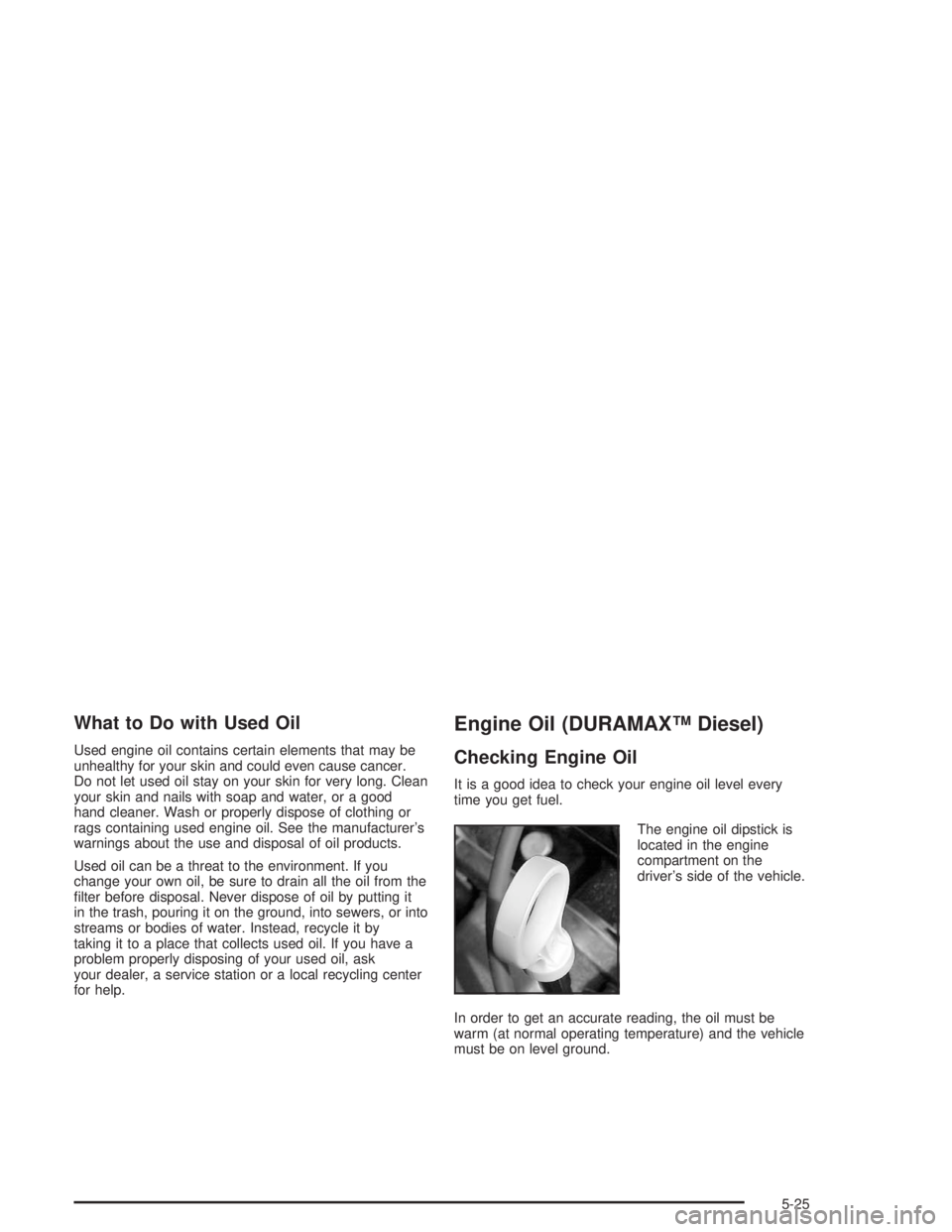
What to Do with Used Oil
Used engine oil contains certain elements that may be
unhealthy for your skin and could even cause cancer.
Do not let used oil stay on your skin for very long. Clean
your skin and nails with soap and water, or a good
hand cleaner. Wash or properly dispose of clothing or
rags containing used engine oil. See the manufacturer’s
warnings about the use and disposal of oil products.
Used oil can be a threat to the environment. If you
change your own oil, be sure to drain all the oil from the
filter before disposal. Never dispose of oil by putting it
in the trash, pouring it on the ground, into sewers, or into
streams or bodies of water. Instead, recycle it by
taking it to a place that collects used oil. If you have a
problem properly disposing of your used oil, ask
your dealer, a service station or a local recycling center
for help.
Engine Oil (DURAMAX™ Diesel)
Checking Engine Oil
It is a good idea to check your engine oil level every
time you get fuel.
The engine oil dipstick is
located in the engine
compartment on the
driver’s side of the vehicle.
In order to get an accurate reading, the oil must be
warm (at normal operating temperature) and the vehicle
must be on level ground.
5-25
Page 232 of 366
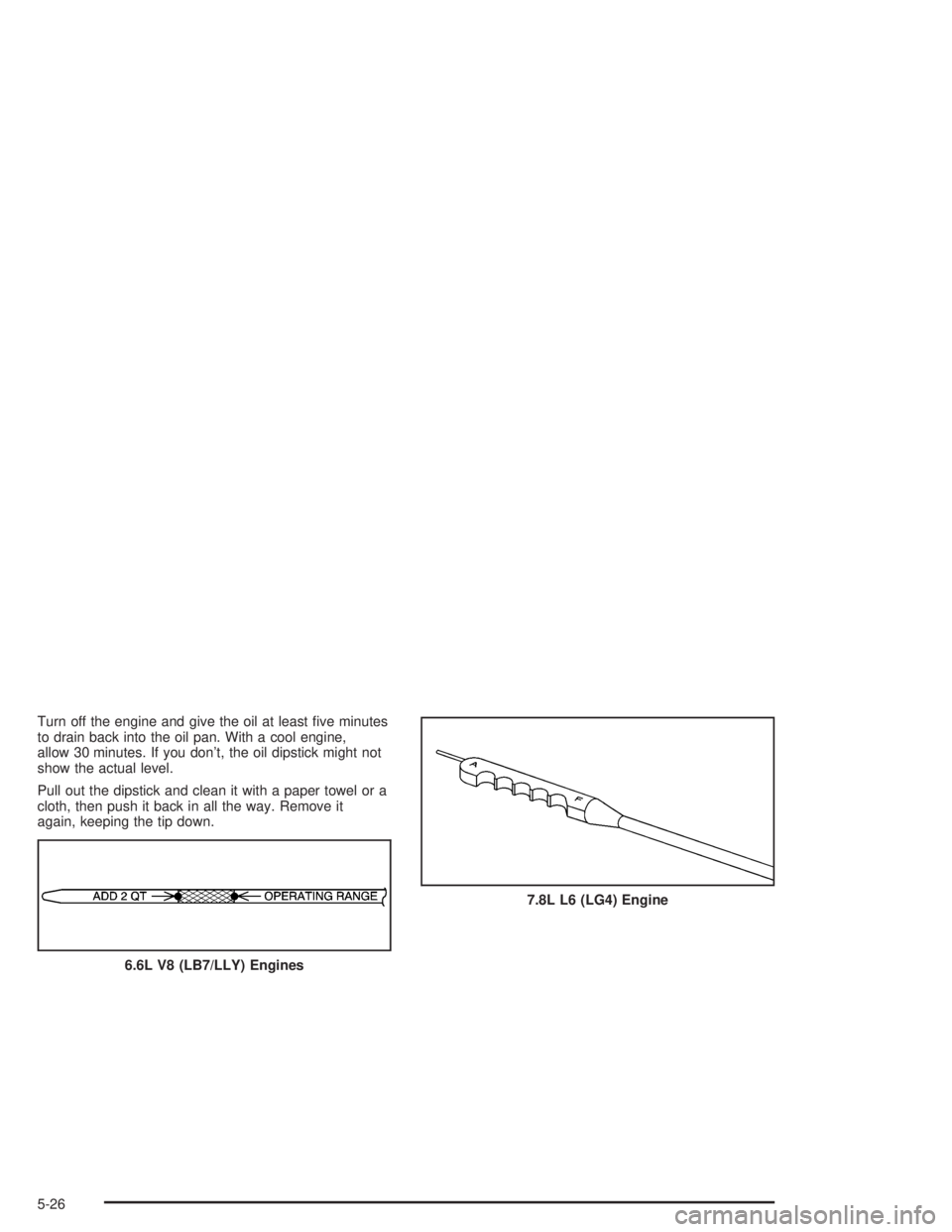
Turn off the engine and give the oil at least five minutes
to drain back into the oil pan. With a cool engine,
allow 30 minutes. If you don’t, the oil dipstick might not
show the actual level.
Pull out the dipstick and clean it with a paper towel or a
cloth, then push it back in all the way. Remove it
again, keeping the tip down.
6.6L V8 (LB7/LLY) Engines
7.8L L6 (LG4) Engine
5-26
Page 233 of 366
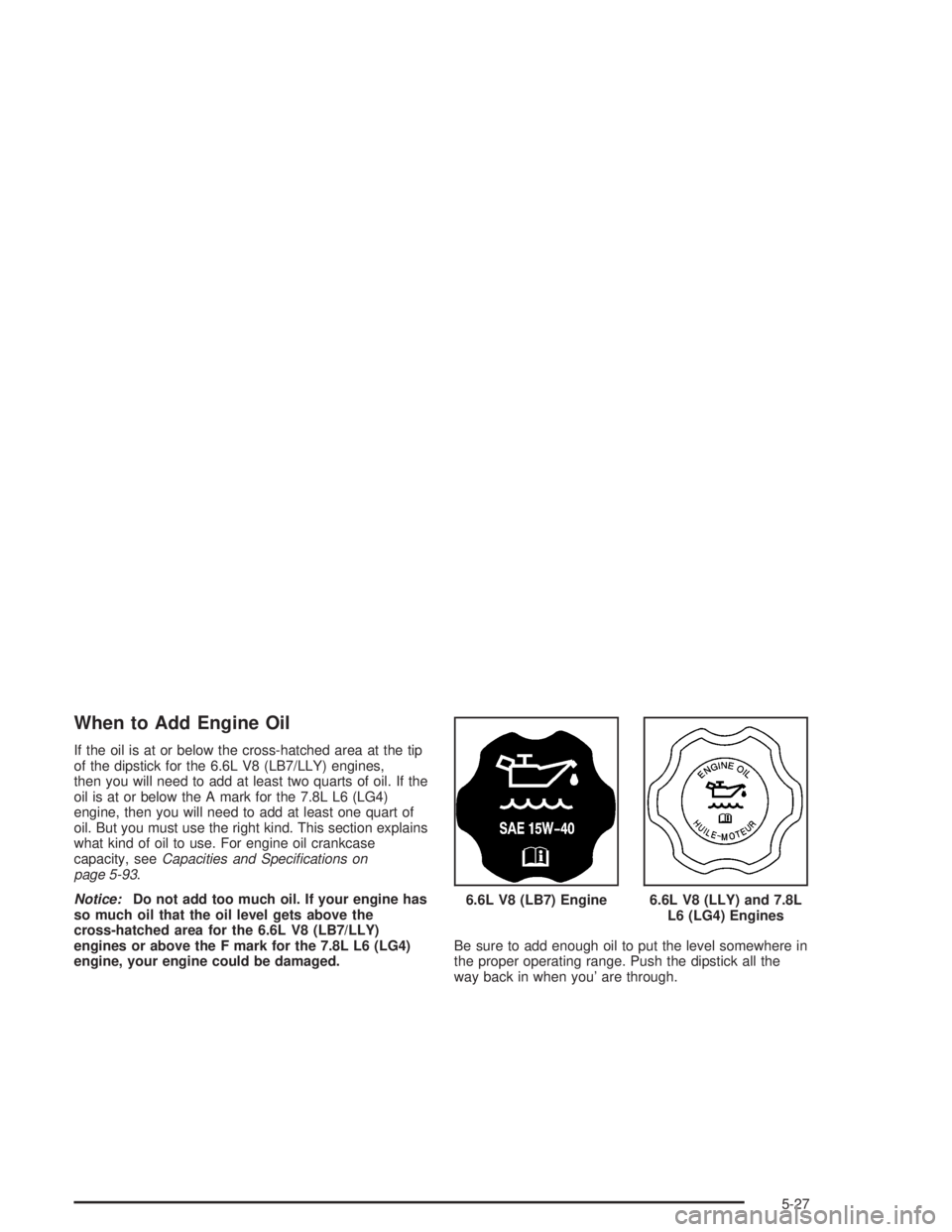
When to Add Engine Oil
If the oil is at or below the cross-hatched area at the tip
of the dipstick for the 6.6L V8 (LB7/LLY) engines,
then you will need to add at least two quarts of oil. If the
oil is at or below the A mark for the 7.8L L6 (LG4)
engine, then you will need to add at least one quart of
oil. But you must use the right kind. This section explains
what kind of oil to use. For engine oil crankcase
capacity, seeCapacities and Speci�cations on
page 5-93.
Notice:Do not add too much oil. If your engine has
so much oil that the oil level gets above the
cross-hatched area for the 6.6L V8 (LB7/LLY)
engines or above the F mark for the 7.8L L6 (LG4)
engine, your engine could be damaged.Be sure to add enough oil to put the level somewhere in
the proper operating range. Push the dipstick all the
way back in when you’ are through.6.6L V8 (LB7) Engine
6.6L V8 (LLY) and 7.8L
L6 (LG4) Engines
5-27
Page 234 of 366
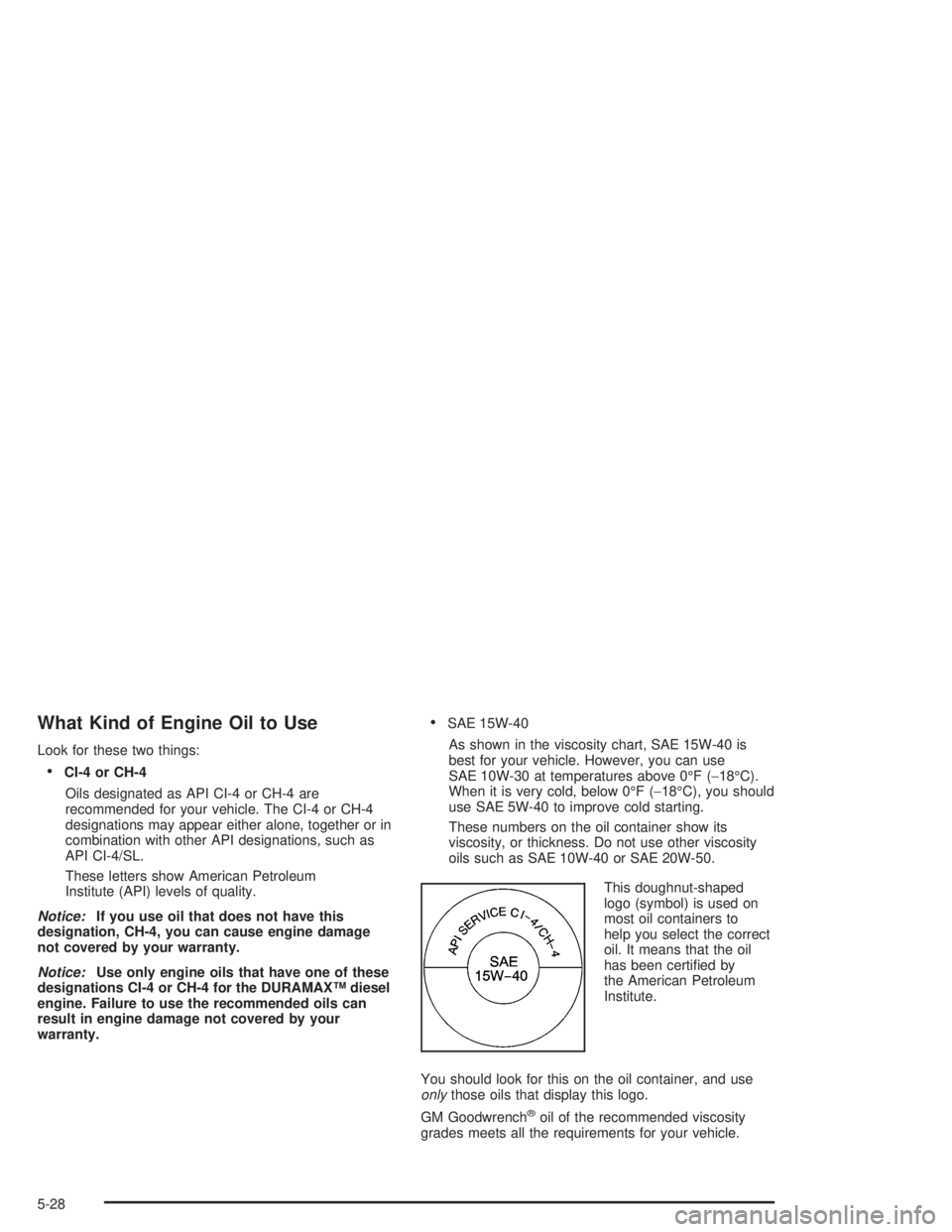
What Kind of Engine Oil to Use
Look for these two things:
•CI-4 or CH-4
Oils designated as API CI-4 or CH-4 are
recommended for your vehicle. The CI-4 or CH-4
designations may appear either alone, together or in
combination with other API designations, such as
API CI-4/SL.
These letters show American Petroleum
Institute (API) levels of quality.
Notice:If you use oil that does not have this
designation, CH-4, you can cause engine damage
not covered by your warranty.
Notice:Use only engine oils that have one of these
designations CI-4 or CH-4 for the DURAMAX™ diesel
engine. Failure to use the recommended oils can
result in engine damage not covered by your
warranty.
•SAE 15W-40
As shown in the viscosity chart, SAE 15W-40 is
best for your vehicle. However, you can use
SAE 10W-30 at temperatures above 0°F (−18°C).
When it is very cold, below 0°F (−18°C), you should
use SAE 5W-40 to improve cold starting.
These numbers on the oil container show its
viscosity, or thickness. Do not use other viscosity
oils such as SAE 10W-40 or SAE 20W-50.
This doughnut-shaped
logo (symbol) is used on
most oil containers to
help you select the correct
oil. It means that the oil
has been certified by
the American Petroleum
Institute.
You should look for this on the oil container, and use
onlythose oils that display this logo.
GM Goodwrench
®oil of the recommended viscosity
grades meets all the requirements for your vehicle.
5-28
Page 235 of 366
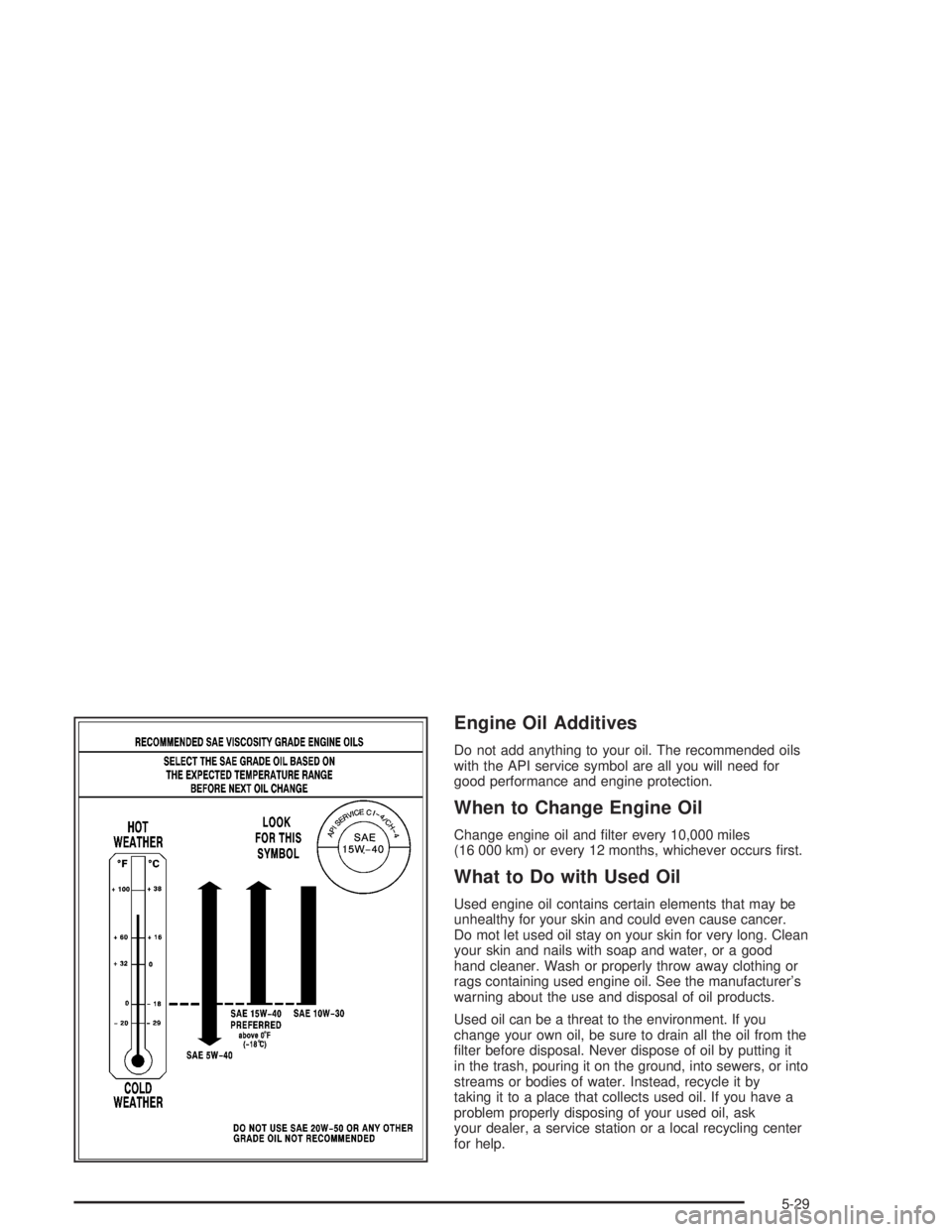
Engine Oil Additives
Do not add anything to your oil. The recommended oils
with the API service symbol are all you will need for
good performance and engine protection.
When to Change Engine Oil
Change engine oil and filter every 10,000 miles
(16 000 km) or every 12 months, whichever occurs first.
What to Do with Used Oil
Used engine oil contains certain elements that may be
unhealthy for your skin and could even cause cancer.
Do mot let used oil stay on your skin for very long. Clean
your skin and nails with soap and water, or a good
hand cleaner. Wash or properly throw away clothing or
rags containing used engine oil. See the manufacturer’s
warning about the use and disposal of oil products.
Used oil can be a threat to the environment. If you
change your own oil, be sure to drain all the oil from the
filter before disposal. Never dispose of oil by putting it
in the trash, pouring it on the ground, into sewers, or into
streams or bodies of water. Instead, recycle it by
taking it to a place that collects used oil. If you have a
problem properly disposing of your used oil, ask
your dealer, a service station or a local recycling center
for help.
5-29
Page 236 of 366
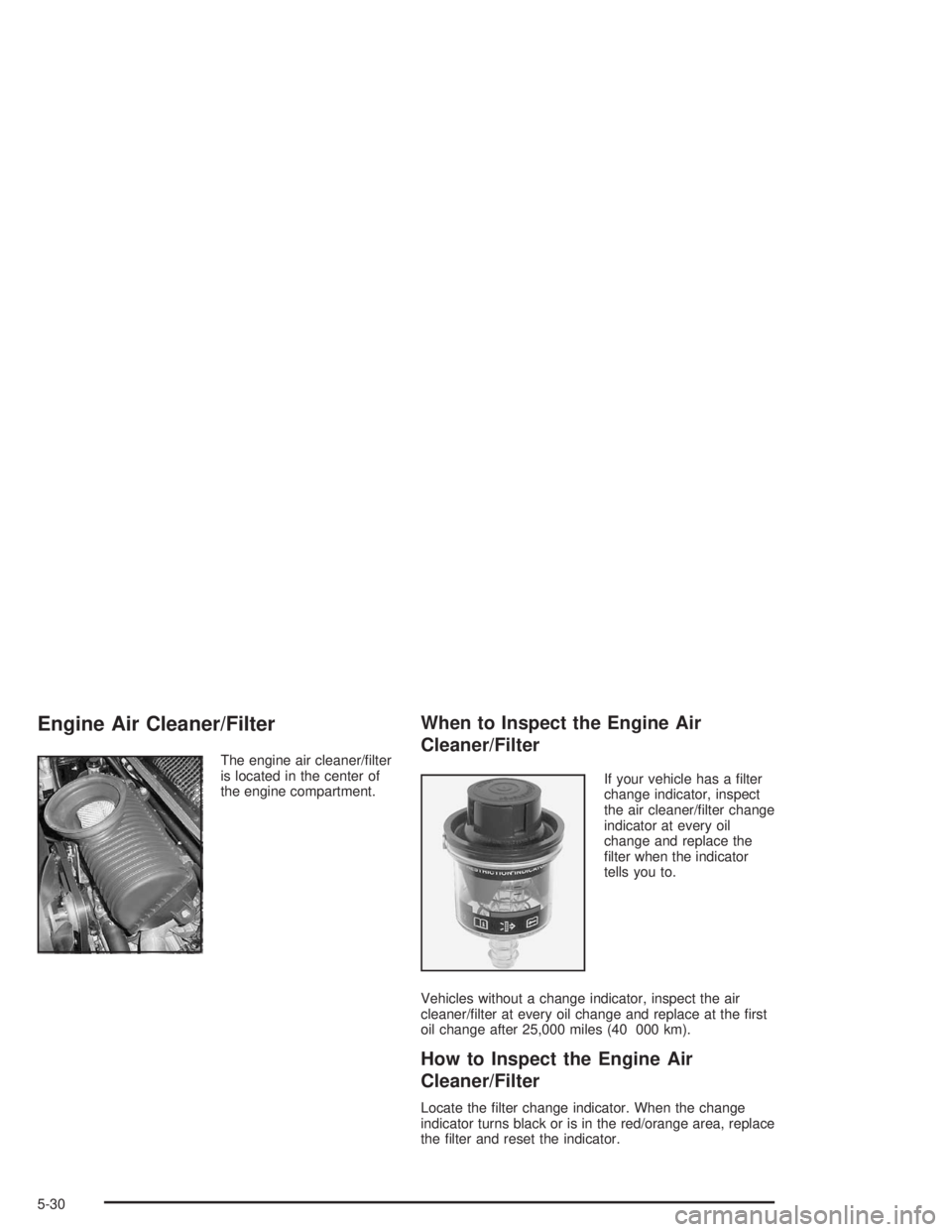
Engine Air Cleaner/Filter
The engine air cleaner/filter
is located in the center of
the engine compartment.
When to Inspect the Engine Air
Cleaner/Filter
If your vehicle has a filter
change indicator, inspect
the air cleaner/filter change
indicator at every oil
change and replace the
filter when the indicator
tells you to.
Vehicles without a change indicator, inspect the air
cleaner/filter at every oil change and replace at the first
oil change after 25,000 miles (40 000 km).
How to Inspect the Engine Air
Cleaner/Filter
Locate the filter change indicator. When the change
indicator turns black or is in the red/orange area, replace
the filter and reset the indicator.
5-30
Page 237 of 366
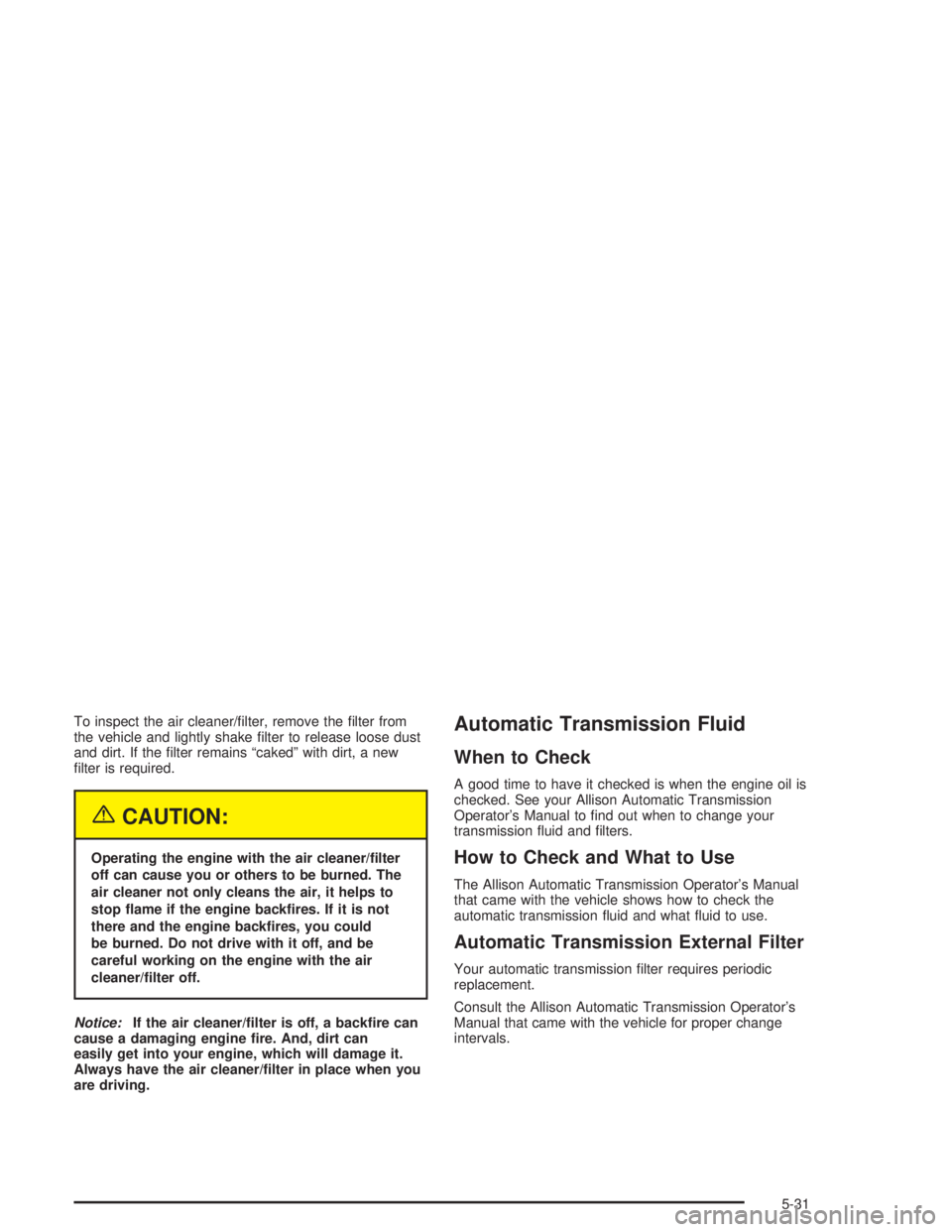
To inspect the air cleaner/filter, remove the filter from
the vehicle and lightly shake filter to release loose dust
and dirt. If the filter remains “caked” with dirt, a new
filter is required.
{CAUTION:
Operating the engine with the air cleaner/�lter
off can cause you or others to be burned. The
air cleaner not only cleans the air, it helps to
stop �ame if the engine back�res. If it is not
there and the engine back�res, you could
be burned. Do not drive with it off, and be
careful working on the engine with the air
cleaner/�lter off.
Notice:If the air cleaner/�lter is off, a back�re can
cause a damaging engine �re. And, dirt can
easily get into your engine, which will damage it.
Always have the air cleaner/�lter in place when you
are driving.
Automatic Transmission Fluid
When to Check
A good time to have it checked is when the engine oil is
checked. See your Allison Automatic Transmission
Operator’s Manual to find out when to change your
transmission fluid and filters.
How to Check and What to Use
The Allison Automatic Transmission Operator’s Manual
that came with the vehicle shows how to check the
automatic transmission fluid and what fluid to use.
Automatic Transmission External Filter
Your automatic transmission filter requires periodic
replacement.
Consult the Allison Automatic Transmission Operator’s
Manual that came with the vehicle for proper change
intervals.
5-31
Page 238 of 366
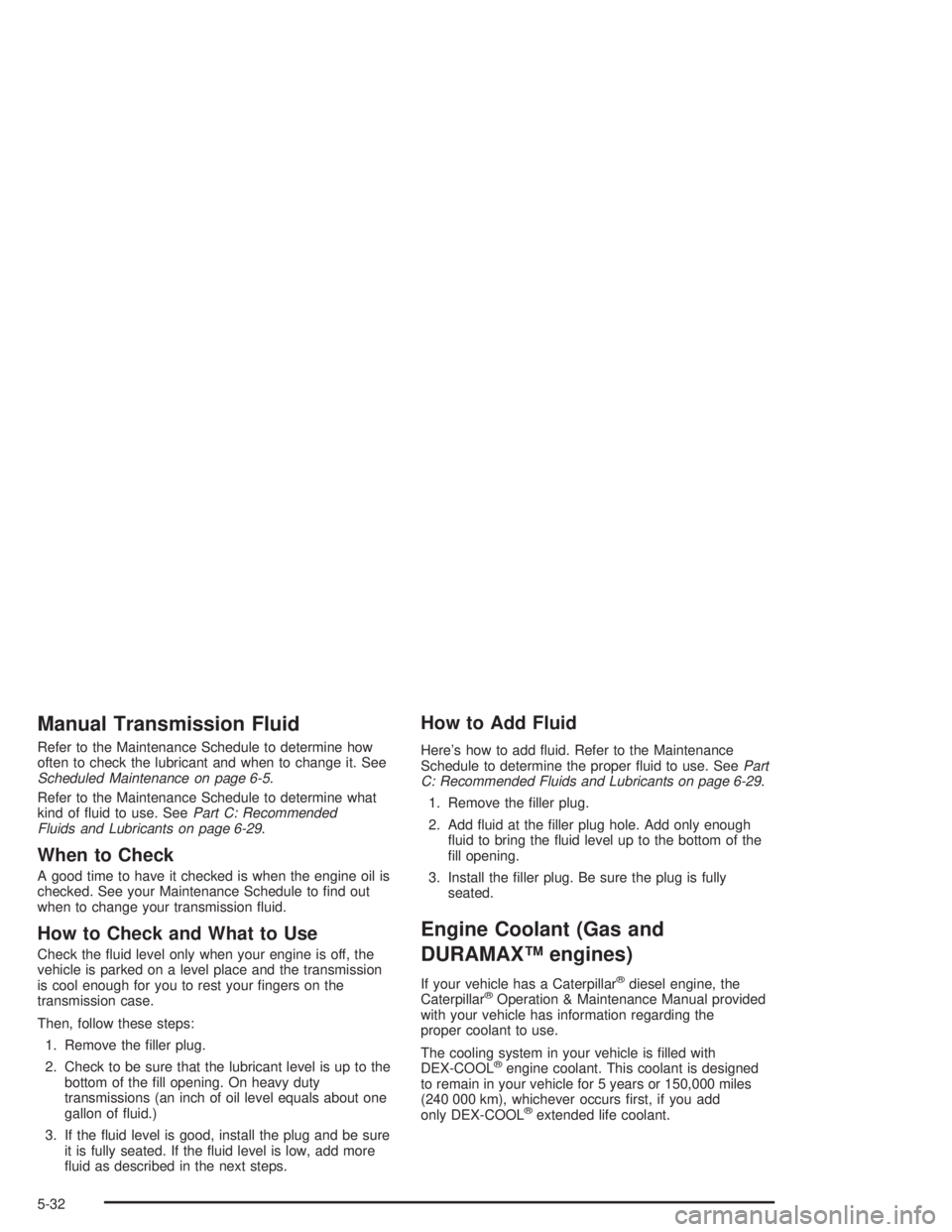
Manual Transmission Fluid
Refer to the Maintenance Schedule to determine how
often to check the lubricant and when to change it. See
Scheduled Maintenance on page 6-5.
Refer to the Maintenance Schedule to determine what
kind of fluid to use. SeePart C: Recommended
Fluids and Lubricants on page 6-29.
When to Check
A good time to have it checked is when the engine oil is
checked. See your Maintenance Schedule to find out
when to change your transmission fluid.
How to Check and What to Use
Check the fluid level only when your engine is off, the
vehicle is parked on a level place and the transmission
is cool enough for you to rest your fingers on the
transmission case.
Then, follow these steps:
1. Remove the filler plug.
2. Check to be sure that the lubricant level is up to the
bottom of the fill opening. On heavy duty
transmissions (an inch of oil level equals about one
gallon of fluid.)
3. If the fluid level is good, install the plug and be sure
it is fully seated. If the fluid level is low, add more
fluid as described in the next steps.
How to Add Fluid
Here’s how to add fluid. Refer to the Maintenance
Schedule to determine the proper fluid to use. SeePart
C: Recommended Fluids and Lubricants on page 6-29.
1. Remove the filler plug.
2. Add fluid at the filler plug hole. Add only enough
fluid to bring the fluid level up to the bottom of the
fill opening.
3. Install the filler plug. Be sure the plug is fully
seated.
Engine Coolant (Gas and
DURAMAX™ engines)
If your vehicle has a Caterpillar®diesel engine, the
Caterpillar®Operation & Maintenance Manual provided
with your vehicle has information regarding the
proper coolant to use.
The cooling system in your vehicle is filled with
DEX-COOL
®engine coolant. This coolant is designed
to remain in your vehicle for 5 years or 150,000 miles
(240 000 km), whichever occurs first, if you add
only DEX-COOL
®extended life coolant.
5-32
Page 239 of 366
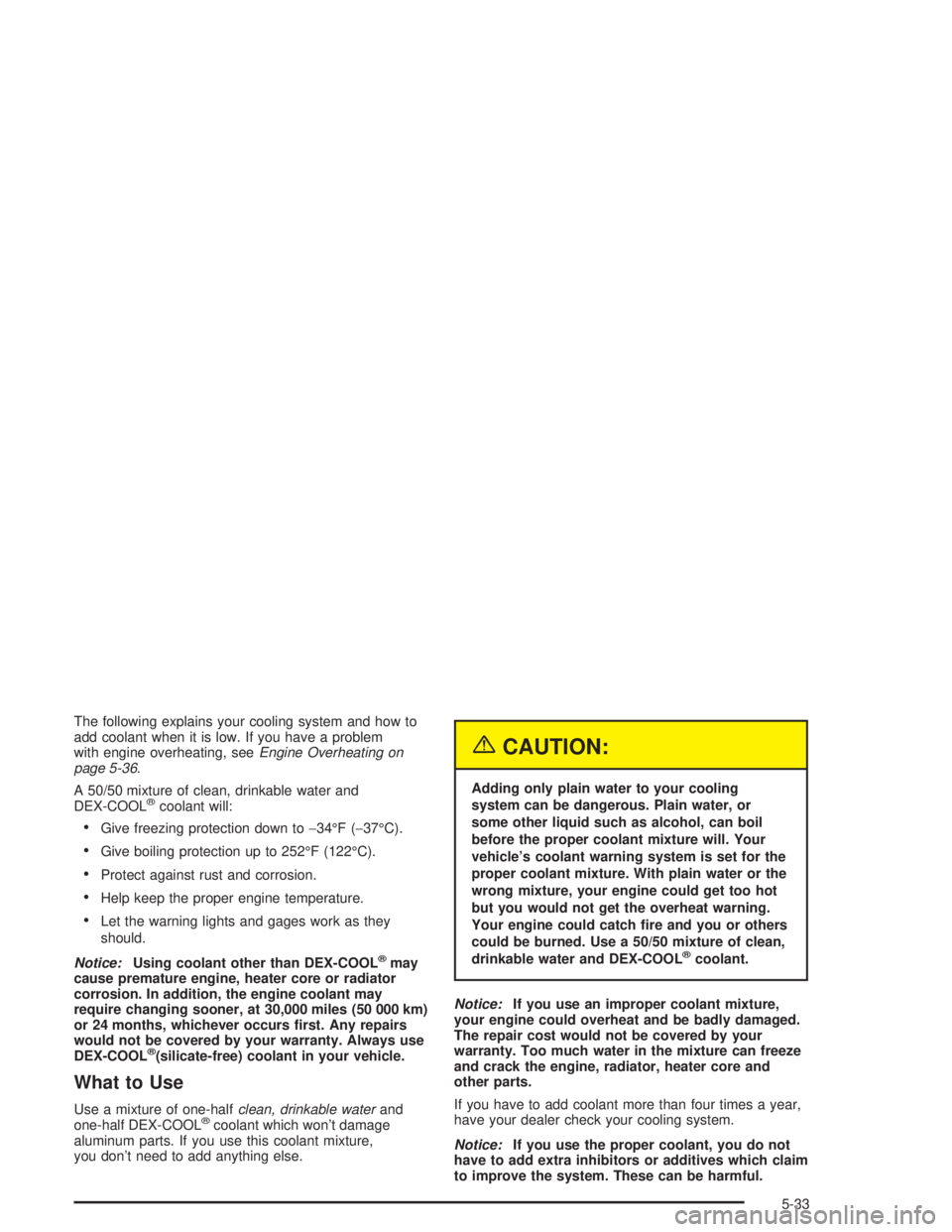
The following explains your cooling system and how to
add coolant when it is low. If you have a problem
with engine overheating, seeEngine Overheating on
page 5-36.
A 50/50 mixture of clean, drinkable water and
DEX-COOL
®coolant will:
•Give freezing protection down to−34°F (−37°C).
•Give boiling protection up to 252°F (122°C).
•Protect against rust and corrosion.
•Help keep the proper engine temperature.
•Let the warning lights and gages work as they
should.
Notice:Using coolant other than DEX-COOL
®may
cause premature engine, heater core or radiator
corrosion. In addition, the engine coolant may
require changing sooner, at 30,000 miles (50 000 km)
or 24 months, whichever occurs �rst. Any repairs
would not be covered by your warranty. Always use
DEX-COOL
®(silicate-free) coolant in your vehicle.
What to Use
Use a mixture of one-halfclean, drinkable waterand
one-half DEX-COOL®coolant which won’t damage
aluminum parts. If you use this coolant mixture,
you don’t need to add anything else.
{CAUTION:
Adding only plain water to your cooling
system can be dangerous. Plain water, or
some other liquid such as alcohol, can boil
before the proper coolant mixture will. Your
vehicle’s coolant warning system is set for the
proper coolant mixture. With plain water or the
wrong mixture, your engine could get too hot
but you would not get the overheat warning.
Your engine could catch �re and you or others
could be burned. Use a 50/50 mixture of clean,
drinkable water and DEX-COOL
®coolant.
Notice:If you use an improper coolant mixture,
your engine could overheat and be badly damaged.
The repair cost would not be covered by your
warranty. Too much water in the mixture can freeze
and crack the engine, radiator, heater core and
other parts.
If you have to add coolant more than four times a year,
have your dealer check your cooling system.
Notice:If you use the proper coolant, you do not
have to add extra inhibitors or additives which claim
to improve the system. These can be harmful.
5-33
Page 240 of 366
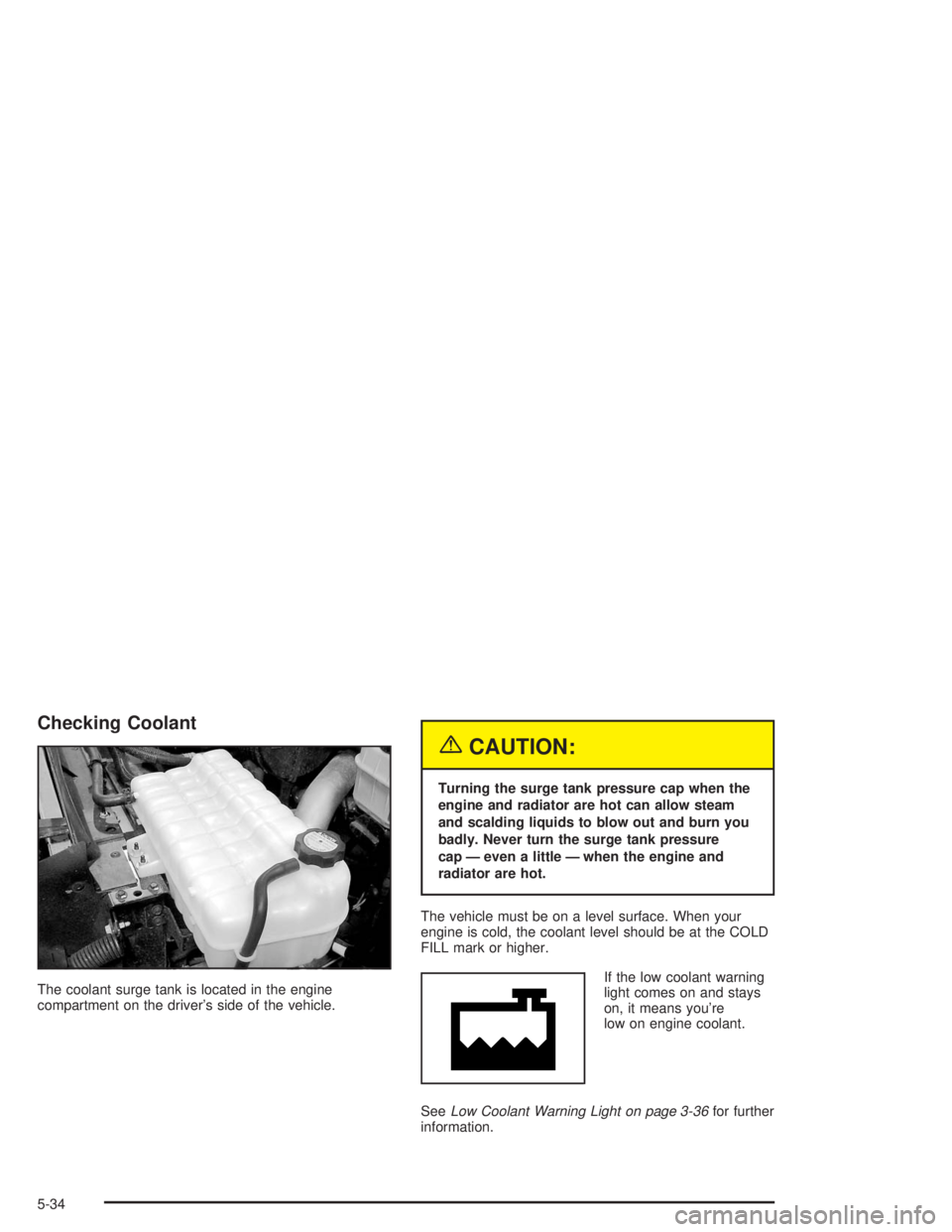
Checking Coolant
The coolant surge tank is located in the engine
compartment on the driver’s side of the vehicle.
{CAUTION:
Turning the surge tank pressure cap when the
engine and radiator are hot can allow steam
and scalding liquids to blow out and burn you
badly. Never turn the surge tank pressure
cap — even a little — when the engine and
radiator are hot.
The vehicle must be on a level surface. When your
engine is cold, the coolant level should be at the COLD
FILL mark or higher.
If the low coolant warning
light comes on and stays
on, it means you’re
low on engine coolant.
SeeLow Coolant Warning Light on page 3-36for further
information.
5-34